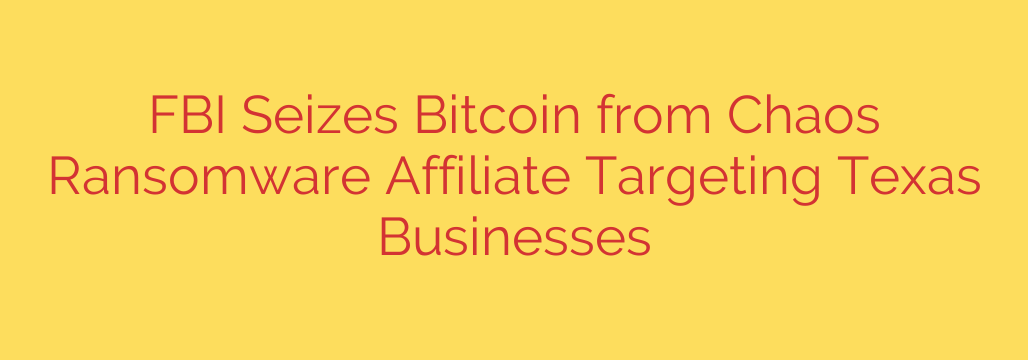
FBI Seizes $1.5 Million in Bitcoin from Chaos Ransomware Affiliate
In a significant victory against cybercrime, federal authorities have successfully seized nearly $1.5 million in Bitcoin from a ransomware affiliate who targeted businesses and critical infrastructure across the United States. The operation dismantled a lucrative scheme that relied on the notorious Chaos ransomware to extort victims, highlighting the growing effectiveness of law enforcement in tracking and recovering illicit cryptocurrency payments.
The investigation centered on a cybercriminal who deployed Chaos ransomware against multiple entities, including a prominent business in North Texas. The attacker successfully encrypted the company’s systems and demanded a ransom payment in Bitcoin to restore access. This incident is a stark example of the Ransomware-as-a-Service (RaaS) model, where developers create and lease malicious software to affiliates who then carry out the attacks in exchange for a share of the profits. This RaaS model significantly lowers the barrier to entry, allowing less sophisticated criminals to launch devastating attacks.
The Investigation and Cryptocurrency Seizure
Following the attack, the FBI’s Dallas Cyber Task Force launched a meticulous investigation. By analyzing the blockchain—the public ledger that records all Bitcoin transactions—agents were able to trace the flow of the ransom payment. They successfully identified the cryptocurrency wallet where the affiliate had consolidated their illicit earnings.
Through legal processes, the FBI obtained the “private key,” or password, to the wallet, enabling them to seize its contents. In total, authorities recovered 39.9 Bitcoin, valued at approximately $1.5 million at the time of the seizure. This operation demonstrates that while cryptocurrency offers a degree of anonymity, it is not untraceable. Law enforcement agencies are increasingly adept at following the digital money trail to bring cybercriminals to justice and recover stolen funds.
A Closer Look at the Chaos Ransomware Threat
The Chaos ransomware variant used in these attacks is particularly dangerous. While it functions like typical ransomware by encrypting files and demanding payment, some versions of Chaos are more destructive. Instead of merely locking files, they are often designed as “wipers,” meaning they overwrite and permanently destroy the original data.
This means that even if a victim pays the ransom, there is no guarantee their files can be recovered. The malware is often disguised as legitimate software or delivered through phishing emails, tricking users into executing it. Once active, it can spread quickly across a network, crippling operations within minutes.
How to Protect Your Business from Ransomware
This case is a powerful reminder that the threat of ransomware is real and growing. Proactive defense is the best strategy. Businesses of all sizes should implement a multi-layered security approach to minimize their risk.
Here are essential, actionable steps to secure your organization:
- Implement Robust Backups: This is your most critical defense. Follow the 3-2-1 rule: maintain at least three copies of your data, on two different types of media, with one copy stored off-site and offline. Regularly test your backups to ensure they can be restored.
- Enforce Multi-Factor Authentication (MFA): MFA is one of the most effective controls to prevent unauthorized access. Require it for all remote access points, privileged accounts, and critical systems.
- Keep All Systems Patched and Updated: Cybercriminals exploit known vulnerabilities in software. Establish a rigorous patch management program to ensure all operating systems, applications (like web browsers and office suites), and security software are always up to date.
- Educate and Train Your Employees: Your staff is your first line of defense. Conduct regular security awareness training to help them identify and report phishing emails, suspicious links, and other social engineering tactics.
- Develop an Incident Response Plan: Don’t wait for an attack to figure out what to do. Create a clear, actionable plan that outlines the steps to take during and after a security incident, including who to contact and how to isolate affected systems to prevent further spread.
While the FBI’s success in this case is a positive development, the fight against ransomware is far from over. By taking these security measures seriously, you can significantly strengthen your defenses and protect your organization from becoming the next victim.
Source: https://securityaffairs.com/180578/cyber-crime/fbi-seizes-20-btc-from-chaos-ransomware-affiliate.html








